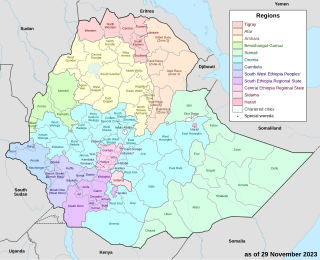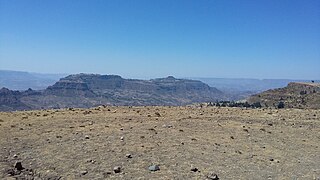Demographics
Based on the 2007 national census conducted by the Central Statistical Agency of Ethiopia (CSA), this woreda has a total population of 128,045, an increase of 28.25% over the 1994 census, of whom 64,102 are men and 63,943 women; 5,010 or 3.91% are urban inhabitants. With an area of 626.14 square kilometers, Debay Tilatgen has a population density of 204.50, which is greater than the Zone average of 153.8 persons per square kilometer. A total of 29,043 households were counted in this woreda, resulting in an average of 4.41 persons to a household, and 28,205 housing units. The majority of the inhabitants practiced Ethiopian Orthodox Christianity, with 99.43% reporting that as their religion. [3]
The 1994 national census reported a total population for this woreda of 99,840 in 22,060 households, of whom 50,591 were men and 49,249 were women; 2,162 or 2.17% of its population were urban dwellers. The largest ethnic group reported in Debay Telatgen was the Amhara (99.95%). The majority of the inhabitants practiced Ethiopian Orthodox Christianity, with 99.47% reporting that as their religion, while 3.69% were Muslim. [4]

Koore Zone (amaro)is a zone in South Ethiopia Regional State of Ethiopia. The people are called Koore and their language is Koorete. Amaro is one of the areas in which members of Koore nations widely live in. Koore got zonal status in August 2023 upon the formation of the South Ethiopia Regional State. In 2011, the Segen Area Peoples Zone was established, which includes Amaro woreda and the 3 former special woredas surrounding it. Located in the Great Rift Valley, koore is bordered on the south by Burji Zone, on the southwest by Konso Zone, on the west by Dirashe Zone, on the northwest by Gamo Zone and Lake Chamo, and on the north by Lake Abaya and in east and northeast by Oromia Region. It is divided into 35 kebeles. The administrative center of the woreda is Kelle. Jijola woreda, Derba Menena woreda, and Kereda are other growing municipals of the zone.
Debre Berhan Zuria or Basona Werana is a woreda in the Amhara Region of Ethiopia. Located at the eastern edge of the Ethiopian highlands in the Semien Shewa Zone, Basona Werana is bordered on the south by Angolalla Tera, on the southwest by the Oromia Region, on the west by Siyadebrina Wayu, on the northwest by Moretna Jiru, on the north by Mojana Wadera, on the northeast by Termaber, and on the east by Ankober. The town and woreda of Debre Berhan is an enclave inside this woreda. Towns in this woreda include Gudoberet.
Hulet Ej Enese is one of the woredas in the Amhara Region of Ethiopia. Part of the Misraq Gojjam Zone, it is bordered on the south by Debay Telatgen, on the west by Bibugn and Goncha, on the northwest by the Mirab Gojjam Zone, on the north by the Abay River, on the east by Goncha Siso Enese, and on the southeast by Enarj Enawga. Among the towns in this administrative division are Keraniyo, Mota and Sede.
Wegera or Wogera, is a woreda in Amhara Region, Ethiopia. Wegera is named for the former province Wegera, which was located roughly in the same location, and was later made part of the province of Semien. Part of the Semien Gondar Zone, Wegera is bordered on the south by Mirab Belessa, on the southwest by Gondar Zuria, on the west by Lay Armachiho, on the northwest by Tach Armachiho, on the north by Dabat, on the northeast by Jan Amora, and on the southeast by Misraq Belessa. Towns in Wegera include Amba Giyorgis and Gedegbe.
Dera is one of the woredas in the Amhara Region of Ethiopia. Part of the Debub Gondar Zone, Dera is bordered on the south and west by the Bahir Dar city,Zenzelma subcity located in Semien Gojjam zone,
Wadla is a woreda in Amhara Region, Ethiopia. It is named for the former district which lay roughly in the same area. Part of the Semien Wollo Zone, Wadla is bordered on the southeast by Delanta, on the southwest by Dawunt, on the north by Meket, and on the northeast by Guba Lafto. The major town in Wadla is Gashena. Other towns include Kone and Arbit.
Habru is a woreda in the Amhara Region of Ethiopia. Part of the Semien Wollo Zone, Habru is bordered on the south by the Mille River which separates it from the Debub Wollo Zone, on the west by Guba Lafto, on the north by the Alewuha River which separates it from Kobo, and on the east by the Afar Region. Towns in Habru include Mersa and Wurgessa.

Mekdela is a woreda in Amhara Region, Ethiopia. Part of the Wollo, Mekdela is bordered on the southwest by the Walo Shabatala River which separates it from Sayint, on the west by Semien Gondar Zone, on the north by the Bashilo River which separates it from the Semien Wollo Zone, and on the east by Tenta. The major town in Mekdelais Masha.
Kelala is one of the woredas in the Amhara Region of Ethiopia. Part of the Debub Wollo Zone, Kelala is bordered on the south by the Semien Shewa Zone, on the southwest by the Walaqa River which separates it from the Oromia Region, on the west by Wegde, on the north by Legambo, on the northeast by Legahida, and on the east by Jama. Towns in Kelala include Kelala and Liguama. Kelala town is 157 km far from Dessie in the Western direction.
SekotaZuria is one of the woredas in the Amhara Region of Ethiopia. Located in the Wag Hemra Zone, Sekota is bordered on the south by Gazbibla, on the southwest by Dehana, on the west by Zikuala, on the north by Abergele, and on the east by the Tigray Region. The separate woreda of town of Soqota is surrounded by Sekota. Abergele woreda was separated from Sekota.
Merhabete is a woreda in Amhara Region, Ethiopia. Part of the Semien Shewa Zone, Merhabete is bordered on the south by Ensaro, on the west by the Oromia Region, on the north by Mida Woremo, on the east by Menz Keya Gebreal, and on the southeast by Moretna Jiru. The Jamma River defines this woreda's southern and eastern boundaries, and its tributary the Qechene defines its western and northern. The administrative center is Alem Ketema; other towns in this woreda include Fetira.
Mida Woremo is one of the woredas in the Amhara Region of Ethiopia. Part of the Semien Shewa Zone, Mida Woremo is bordered on the south by the Qechene River which separates it from Merhabiete, on the west by the Oromia Region, and on the north and east by the Debub Wollo Zone; the northern boundary is defined by the Walaqa River. The administrative center of this woreda is Meragna; other towns include Rema.
Enarj Enawga is one of the woredas in the Amhara Region of Ethiopia. Part of the Misraq Gojjam Zone, Enarj Enawga is bordered on the south by Enemay, on the southwest by Debay Telatgen, on the west by Hulet Ej Enese, on the north by Goncha Siso Enese, on the northeast by Enbise Sar Midir, on the east by the Abbay River which separates it from the Debub Wollo Zone, and on the southeast by Shebel Berenta. Towns in Enarj Enawga include Debre Werq and Felege Berhan.
Gozamn is one of the woredas in the Amhara Region of Ethiopia. Part of the East Gojjam Zone, Guzamn is bordered on the southeast by Baso Liben, on the south by the Abay River which separates it from the Oromia Region, on the west by Debre Elias, on the northwest by Machakel, on the north by Sinan, and on the east by Aneded; the Chamwaga River defines part of the border between the Guzamn and Baso Liben woredas. The town and woreda of Debre Marqos is an enclave inside Guzamn. Towns in Guzamn include Chemoga and Yebokile. Sinan woreda was separate from Guzamn.
Awabel is a woreda in Amhara Region, Ethiopia. Part of the Misraq Gojjam Zone, Awabel is bordered on the south by the Abay River which separates it from the Oromia Region, on the west by Aneded, on the northwest by Sinan, on the northeast by Debay Telatgen, and on the east by Dejen. Towns in Awabel include Lumame and Wejel. The woreda of Aneded was separated from Awabel.
Dejen is a woreda in Amhara Region, Ethiopia. This woreda is named after the traditional district it lies in, Dejen, which is best known as where Admas Mogasa, the widow of Emperor Menas, raised the future Emperor Susenyos and instructed him in "the doctrine of the holy books." Part of the Misraq Gojjam Zone, Dejen is bordered on the south by the Abay River which separates it from the Oromia Region, on the west by Awabel, on the northwest by Debay Telatgen, on the north by Enemay, and on the east by Shebel Berenta. The major town in Dejen is Dejen.
Dega Damot is one of the woredas in the Amhara Region of Ethiopia. Part of the Mirab Gojjam Zone, Dega Damot is bordered on the south by Dembecha, on the southwest by Jabi Tehnan, on the west by Kuarit, and on the north and east by the Misraq Gojjam Zone. The major town in Dega Damot is Feres Bet.
Dembecha Zuria is one of the woredas in the Amhara Region of Ethiopia. Part of the Mirab Gojjam Zone, Dembecha is bordered on the west by Bure, on the northwest by Jabi Tehnan, on the north by Dega Damot, and on the east and south by the Misraq Gojjam Zone. Towns in Dembecha include Addis Alem, Dembecha and Yechereka.
Jabi Tehnan is one of the woredas in the Amhara Region of Ethiopia. Part of the Mirab Gojjam Zone, Jabi Tehnan is bordered on the southeast by Dembecha, on the west by Bure, on the northwest by Sekela, on the north by Kuarit, and on the east by Dega Damot. The town and separate woreda of Finote Selam is surrounded by Jabi Tehnan. Towns in Jabi Tehnan include Jiga, Maksegnit and Mankusa.
Bati is a district in the Oromia Zone of the Amhara region of Ethiopia. Bati is bordered on the south by Dawa Harewa, on the southeast by the Argobba special woreda, on the west and north by the Debub Wollo Zone, and on the east by the Afar Region. Towns in this woreda include its administrative center, the market town of Bati. The towns of Degan and Gerba were administratively part of Bati before the 2007 census but was then transferred to Kalu woreda.


